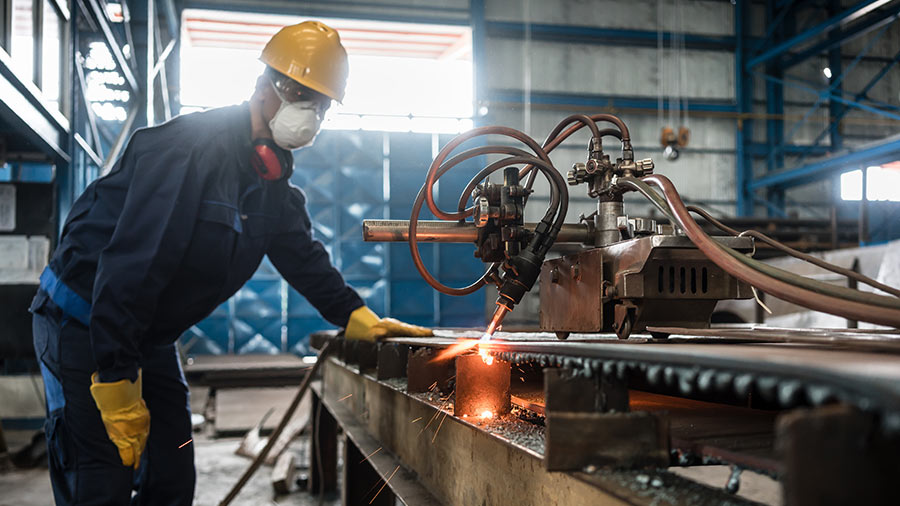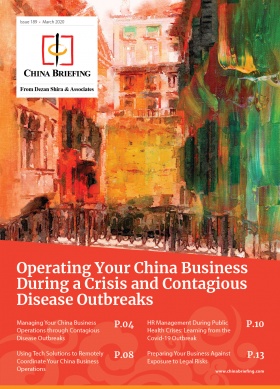Why China’s COVID-19 Stimulus Will Look Different Than in the Past
China is preparing stimulus measures to give the economy a jolt as it recovers from the COVID-19 coronavirus.
The government’s quarantine and pandemic management measures over the past three months have brought China’s economy to a standstill. Now, just as China navigates its return to normalcy, the outbreak appears to be accelerating in the rest of the world – especially in Europe and North America – resulting in plummeting overseas demand for Chinese exports. After having registered 6.1 percent GDP growth in 2019, the World Bank now projects China could grow by just 2.3 percent in 2020.
In the face of these dire economic challenges, the Chinese government is expected to announce a significant stimulus package to rev its economy back to life. In many ways, the situation is reminiscent of the 2008 global financial crisis, when the Chinese government spent enormous sums of money to power its economy through a global downturn.
This time around, however, China’s stimulus measures are likely to be considerably different than they were in 2008. Not only does the Chinese government now have less room to spend due to high levels of debt, but, with different strategic priorities, the form of the stimulus itself is likely to differ from before.
With investments in advanced technologies and clean energy, China’s incoming stimulus measures are poised to give the economy a boost in the immediate term while also providing building blocks for a new sustainable and technology-driven economic model going forward.
China’s 2008 financial stimulus
In response to the global financial crisis in 2008, the Chinese government spent billions of dollars to boost the domestic economy and maintain high growth rates. Most notably, these efforts included a RMB 4 trillion (US$575 billion) stimulus package – equivalent to about 13 percent of China’s 2008 GDP and the largest stimulus in the country’s history.
Most of this stimulus went towards backing various government-led projects, particularly hard infrastructure like high speed rail lines, train stations, metro systems, and airports. For instance, in response to the crisis, China’s railway planners expanded their already ambitious plans to build 16,000 km of high speed rail by 2020, up from the initial goal of 12,000 km.
Ultimately, China’s stimulus proved effective in maintaining economic growth. Although lower than the astronomical levels of growth leading up to the crisis – including 12.7 percent growth in 2006 and 14.2 percent in 2007 – China’s economy grew by 9.7 percent in 2008, 9.4 percent in 2009, and 10.6 percent in 2010 despite the recession that occurred in the US, Europe, and elsewhere.
Besides boosting the economy over the medium-term, China’s stimulus measures tangibly impacted the country’s fabric. The vast expansion of high-speed rail, for instance, dramatically transformed day-to-day life in China for countless citizens and businesses, and continue to provide long-term economic benefits.
After COVID-19, smaller but significant stimulus expected
The stimulus that is likely to come in 2020 will differ from 2008 in both size and target.
Before the novel coronavirus hit, China was already walking a fine line between spending enough to prop up economic growth and cutting down high levels of debt that pose a structural threat to its economy’s sustainability.
While China’s 2008 stimulus kept the economy growing, it came at a high price that now constrains the options of the government’s economic planners. For instance, China’s corporate debt to GDP ratio is 156.7 percent, which is the highest in the world.
The threats to the economy are, however, at least as big as they were in 2008 – if not more so – and the stimulus package will likely be sizable.
According to Reuters, the Chinese government is considering spending up to RMB 2.8 trillion (US$394 billion) in local government special bonds to spur infrastructure investment. Though such a figure would be a much smaller percentage of GDP than the 2008 stimulus, it would still be significant.
Investing in the infrastructure of the future
Whereas China’s 2008 stimulus helped build high quality but relatively basic infrastructure like roads, bridges, and trains, the stimulus in 2020 will likely be more targeted towards areas that will help China transition to a high-tech and service-driven economy.
China built massive amounts of infrastructure during its economic boom, meaning that there are now diminishing returns to further infrastructure investments in new projects. Accordingly, government planners are reportedly focusing on investing in “new infrastructure”.
Broadly speaking, “new infrastructure” refers to infrastructure used for high-tech and sustainable purposes. This includes, for example, big data centers, 5G infrastructure, and charging stations for new energy vehicles (NEVs), among other areas.
Investments in areas such as these would fall in line with the Chinese government’s ambitions to transition from polluting, export-led manufacturing economy towards a high-tech and service-driven one. Whereas China previously needed infrastructure to help move large numbers of people and massive quantities of goods, now China needs infrastructure that will help the economy operate more efficiently and sustainably.
A non-linear approach required
What complicates investment in new infrastructure, however, is its diffuse and more uncertain nature.
Previous stimulus spending gave a large role to state-owned enterprises (SOEs) to participate in the construction of major projects. The entities that specialize in new infrastructure, in contrast, are more varied.
In some cases, they may include SOEs, but in others they may be better executed by private firms like the tech giants Alibaba, Tencent, and Baidu, as well as start-up enterprises. How funding is distributed – and how projects straddle public and private goals – may therefore become a complicated and contentious issue.
Moreover, the return on investment on new infrastructure is arguably riskier and less certain than is the case with hard infrastructure. For example, when building a bridge to connect two cities, there is a fairly certain economic and social benefit that can be calculated in advance, regardless if a project meets challenges.
In contrast, new infrastructure involves areas that are still in their emerging stages of development.
NEV technology, for example, is far from established, and Internet of Things (IoT)-enabled technology will not take off in earnest until 5G infrastructure is running and its networks are widespread. While investments in such fields very well may prove prudent, it is less clear what role new infrastructure will play even one or two decades from now.
What the economic boost will look like
As China recovers from the novel coronavirus, government authorities will likely turn their attention from crisis management to restoring the economy.
Both the domestic and international economic situation call for concerted government action to spur the economy. Although China’s debt levels preclude a 2008-level stimulus, government spending this year is likely to be the biggest since then.
Foreign investors of all stripes will benefit from an economy that returns to – or at least approaches – China’s accustomed levels of high growth. Meanwhile, those operating in areas relating to new infrastructure like emerging high-tech and clean energy may be able to capture new opportunities as a result of stimulus measures.
While China’s GDP growth is all but certain to be lower than the 6 percent observers expected before the crisis, government efforts could potentially lead to growth approaching 5 percent. The exact nature of the economic stimulus and the official growth target for the year will likely be answered in the coming weeks, when Chinese Premier Li Keqiang delivers the annual Work Report on the government’s policy agenda.
Related Reading
 China After COVID-19: How Foreign Companies Can Leverage Key IT Solutions
China After COVID-19: How Foreign Companies Can Leverage Key IT Solutions
 China’s Support Policies for Businesses Under COVID-19: A Comprehensive List
China’s Support Policies for Businesses Under COVID-19: A Comprehensive List
 China’s Social Credit System: COVID-19 Triggers Some Exemptions, Obligations for Businesses
China’s Social Credit System: COVID-19 Triggers Some Exemptions, Obligations for Businesses
About Us
China Briefing is written and produced by Dezan Shira & Associates. The practice assists foreign investors into China and has done since 1992 through offices in Beijing, Tianjin, Dalian, Qingdao, Shanghai, Hangzhou, Ningbo, Suzhou, Guangzhou, Dongguan, Zhongshan, Shenzhen, and Hong Kong. Please contact the firm for assistance in China at china@dezshira.com.
We also maintain offices assisting foreign investors in Vietnam, Indonesia, Singapore, The Philippines, Malaysia, and Thailand in addition to our practices in India and Russia and our trade research facilities along the Belt & Road Initiative.
- Previous Article China to Recover Production in 2021, US and EU Face Sluggish COVID-19 Rebound
- Next Article China Plus One Series: Investment Opportunities in Thailand







